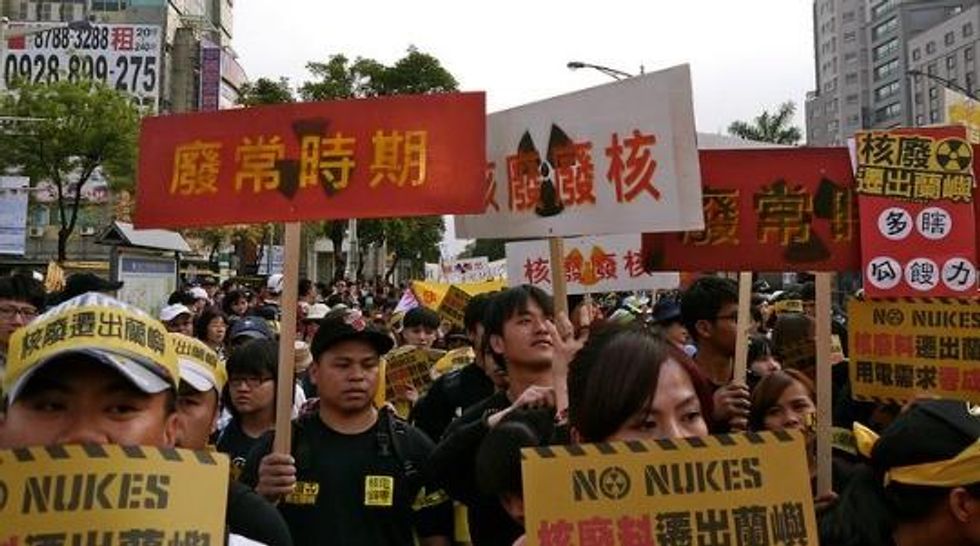

SUBSCRIBE TO OUR FREE NEWSLETTER
Daily news & progressive opinion—funded by the people, not the corporations—delivered straight to your inbox.
5
#000000
#FFFFFF
To donate by check, phone, or other method, see our More Ways to Give page.


Daily news & progressive opinion—funded by the people, not the corporations—delivered straight to your inbox.

Though new leaks were not found, the hotspots detected Thursday were emitting between 70 and 100 millisieverts an hour, the high end of which is the maximum exposure allowed for nuclear plant workers over a five-year period, and the same amount workers detected in pools of leaked water on Tuesday.
TEPCO's announcement two days ago that 300 metric tons of water had leaked from a storage tank prompted Japanese authorities to up the threat level to "serious," and marked only the latest in a series of leaks and mishaps in the never-ending emergency at the disaster-stricken nuclear plant.
As bad as the situation seems, Mycle Schneider, lead author for the World Nuclear Industry status reports, told BBC News that the situation "is much worse than we have been led to believe, much worse."
He warned that they are dealing with "absolutely gigantic" amounts of radioactive water, and that there were leaks "not just from the tanks. It is leaking out from the basements, it is leaking out from the cracks all over the place. Nobody can measure that," Schneider told BBC.
Apart from the unsustainable contaminated water-storage system and leak after leak allowing radioactivity to pour into the ground and ocean, alarms were raised over plans to remove fuel rods containing radioactive material equivalent to 14,000 times the amount released in the atomic bombing of Hiroshima, a plan that "has never been attempted before on this scale."
________________________
Political revenge. Mass deportations. Project 2025. Unfathomable corruption. Attacks on Social Security, Medicare, and Medicaid. Pardons for insurrectionists. An all-out assault on democracy. Republicans in Congress are scrambling to give Trump broad new powers to strip the tax-exempt status of any nonprofit he doesn’t like by declaring it a “terrorist-supporting organization.” Trump has already begun filing lawsuits against news outlets that criticize him. At Common Dreams, we won’t back down, but we must get ready for whatever Trump and his thugs throw at us. As a people-powered nonprofit news outlet, we cover issues the corporate media never will, but we can only continue with our readers’ support. By donating today, please help us fight the dangers of a second Trump presidency. |

Though new leaks were not found, the hotspots detected Thursday were emitting between 70 and 100 millisieverts an hour, the high end of which is the maximum exposure allowed for nuclear plant workers over a five-year period, and the same amount workers detected in pools of leaked water on Tuesday.
TEPCO's announcement two days ago that 300 metric tons of water had leaked from a storage tank prompted Japanese authorities to up the threat level to "serious," and marked only the latest in a series of leaks and mishaps in the never-ending emergency at the disaster-stricken nuclear plant.
As bad as the situation seems, Mycle Schneider, lead author for the World Nuclear Industry status reports, told BBC News that the situation "is much worse than we have been led to believe, much worse."
He warned that they are dealing with "absolutely gigantic" amounts of radioactive water, and that there were leaks "not just from the tanks. It is leaking out from the basements, it is leaking out from the cracks all over the place. Nobody can measure that," Schneider told BBC.
Apart from the unsustainable contaminated water-storage system and leak after leak allowing radioactivity to pour into the ground and ocean, alarms were raised over plans to remove fuel rods containing radioactive material equivalent to 14,000 times the amount released in the atomic bombing of Hiroshima, a plan that "has never been attempted before on this scale."
________________________

Though new leaks were not found, the hotspots detected Thursday were emitting between 70 and 100 millisieverts an hour, the high end of which is the maximum exposure allowed for nuclear plant workers over a five-year period, and the same amount workers detected in pools of leaked water on Tuesday.
TEPCO's announcement two days ago that 300 metric tons of water had leaked from a storage tank prompted Japanese authorities to up the threat level to "serious," and marked only the latest in a series of leaks and mishaps in the never-ending emergency at the disaster-stricken nuclear plant.
As bad as the situation seems, Mycle Schneider, lead author for the World Nuclear Industry status reports, told BBC News that the situation "is much worse than we have been led to believe, much worse."
He warned that they are dealing with "absolutely gigantic" amounts of radioactive water, and that there were leaks "not just from the tanks. It is leaking out from the basements, it is leaking out from the cracks all over the place. Nobody can measure that," Schneider told BBC.
Apart from the unsustainable contaminated water-storage system and leak after leak allowing radioactivity to pour into the ground and ocean, alarms were raised over plans to remove fuel rods containing radioactive material equivalent to 14,000 times the amount released in the atomic bombing of Hiroshima, a plan that "has never been attempted before on this scale."
________________________